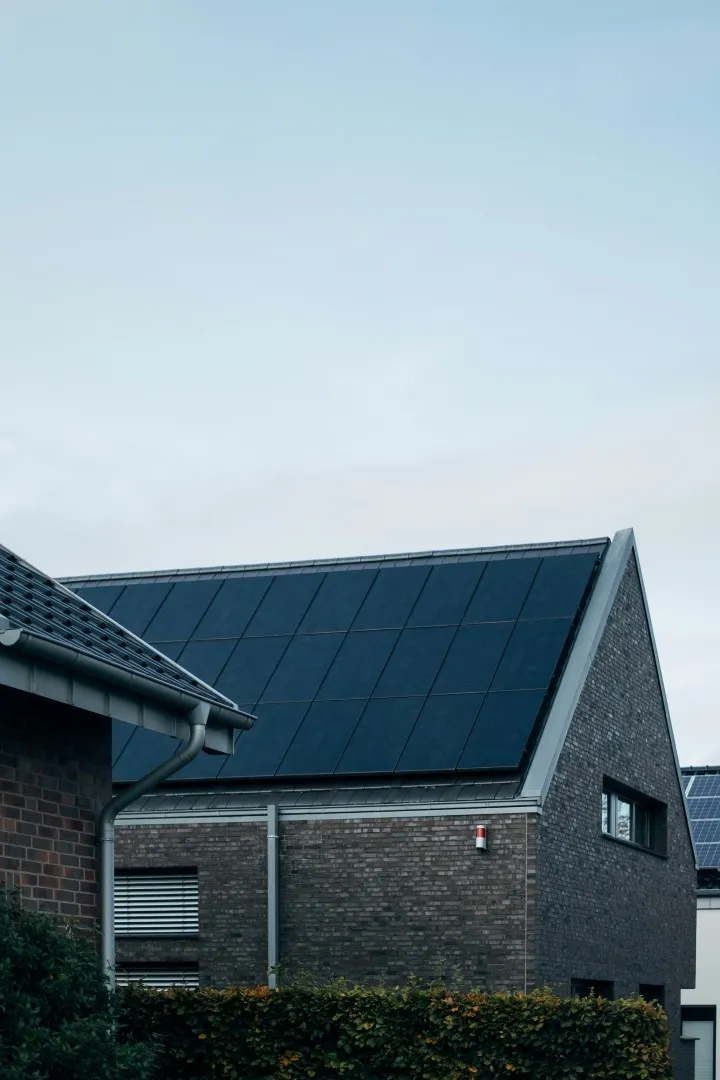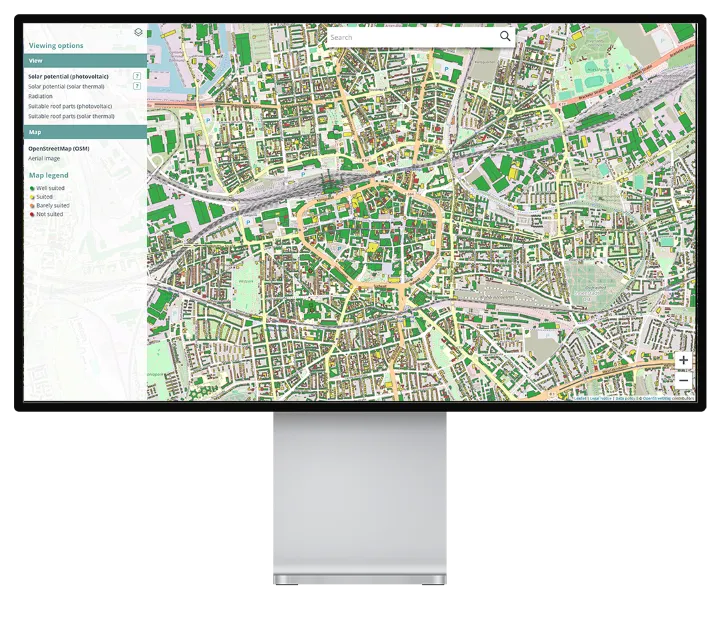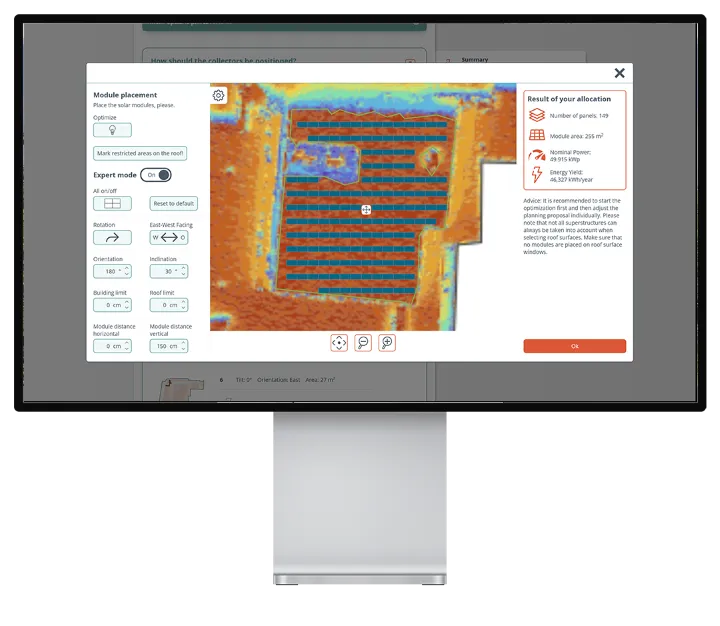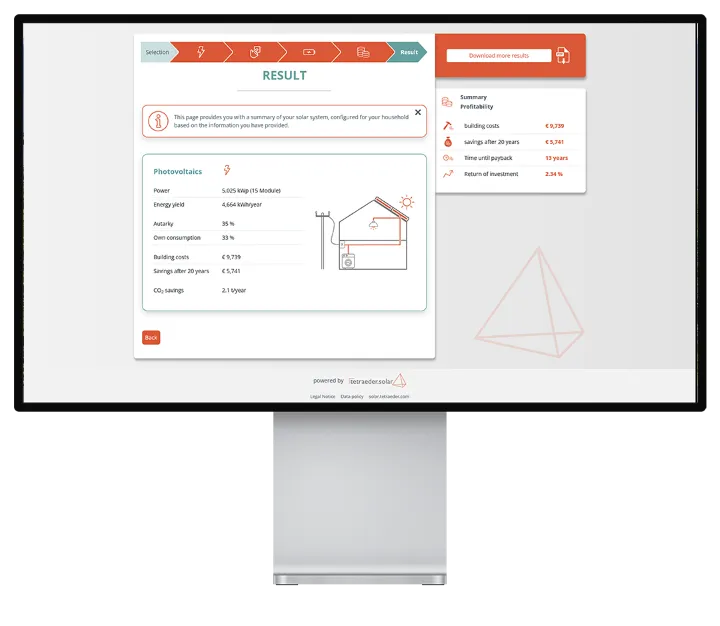Use more solar on your roof!
Solar Potential Map
Effectively promote the energy transition in your municipality: with a solar potential map. Citizens, homeowners and tradespeople can see the solar potential of the analyzed roof areas at a glance. Meaningful data and evaluations support you in your public relations work or at information events.
The individual building analysis includes, among other things, local weather data, possible shading on the roof surfaces and any disruptive roof structures. The solar potential map allows you to individually analyze yield and demand.

Product Features
Users benefit from this
The interactive maps show the possible potential.
They show the suitability of buildings for the use of solar energy in an urban area.
They show the suitability of the roof surface for photovoltaics and solar thermal energy in different color-coded suitability levels.
They clearly illustrate the usable solar irradiation and shading on the roof surfaces.
They present a detailed representation of the roof areas suitable for the installation of the systems.
Process
How does the solar potential map work?
Planning by users
This allows your users to plan an optimal solar system
The customer journey is intuitive, supporting the individual configuration of a solar system. Average values are sufficient, making extensive technical knowledge unnecessary. The calculation is possible for both private and commercial properties. Combining solar thermal energy, photovoltaics, and electricity storage is very simple. Individual load profiling allows for the inclusion of additional electricity consumers like electric vehicles or heat pumps in the system simulation. The effects of an electricity storage system on monthly and daily levels, as well as on self-sufficiency and self-consumption, are calculated. Dynamic module prices are integrated, and there is a choice between full and surplus feed-in. The economic efficiency and amortization period for both credit and self-financing can be calculated. Creating an individual overview in PDF format for optimal roof use is easy.
module placer
What the module placer does
- A good basis for detailed advice from a tradesman.
- Photovoltaic modules as well as solar thermal collectors can be placed on a roof surface and the system can thus be adapted to individual needs and requirements.
- Individual adjustment of the size dimensions and performance parameters as well as alignment of the planned system.
cost-effectiveness calculator
What the profitability calculator does
- Detailed statements on the economic efficiency of the system
- Calculation of independence, amortization and return on investment
- Precise results thanks to the inclusion of essential calculation parameters
- Continuous adjustment of framework conditions such as electricity prices or changes in feed-in tariffs



Your advantages of a solar potential map at a glance
Our technology for more solar potential
Three-dimensional surface models can be processed automatically and together with the data from the public authorities using software developed by us.
Professional and precise analysis
Understandable and comprehensible visualizations
Understandable and comprehensible visualizations
Economic efficiency calculator updated at any time
Interested?
If you would like to find out more about our solar potential map and are interested in working with us, please contact us! We look forward to shaping the future of sustainable energy supply together with you.

aCCOUNT MANAGER
Answers to frequently asked questions
Frequently asked questions
The solar potential register shows the potential for the use of photovoltaics and solar thermal energy in a specific geographical area. The information is individually tailored to each building. This allows you to assess at a glance whether generating climate-friendly energy from sunlight on your roof could be worthwhile or not.
In addition to the basic suitability of a building, the specific parts of the roof areas that are particularly recommended for the installation of a photovoltaic or solar thermal system are also displayed. In addition, the solar radiation intensity is shown in detail for the entire roof.
A photovoltaic system is used to generate electricity from sunlight. A solar thermal system uses the sun to generate hot water and heating. Compared to the solar modules that make up a photovoltaic system, the collectors of a solar thermal system require significantly less space. In individual cases, this can mean that roofs are only suitable for photovoltaics to a limited extent, but can be used well for solar thermal energy. A roof that is well suited for photovoltaics is always also well suited for solar thermal energy.
That is possible and makes sense! After all, both electricity and heat are needed in the building. Due to the small collector area required for solar thermal energy, the remaining available area could be used for photovoltaic modules. Shared use of the area is worth considering. Whether simultaneous implementation is possible or whether both should be pursued must be decided on a case-by-case basis.
It is also possible to combine the use of roof areas for green roofs and the generation of solar energy!
The solar potential analysis is based on laser scan data generated by flying over the area under investigation. This information is used to create a simplified model of the houses and surrounding objects (e.g. trees). In the next step, the roof surfaces are automatically recognized. Irradiation and shading are calculated. Heavily shaded areas are identified as unsuitable. For the remaining roof areas, the irradiation is determined for the course of an entire year. Irradiation is not the same as yield: the efficiency, i.e. the ability of the modules to convert solar radiation into electricity, and the quality of the components used determine the amount of electrical energy generated and therefore also the potential financial yield of a PV system.
As irradiation can vary greatly depending on the region, we use the scientifically validated model results from PV-GIS for each location. These are created, maintained and published by the Joint Research Center of the EU.
The quality of the information provided by the solar potential register depends on the laser scan data available. The higher the data quality, the more roof structures are taken into account in the calculation. Buildings whose data basis does not allow a statement to be made about roof structures are marked separately. As this is an automated process, deviations from the actual roof structure are possible. However, existing smaller roof structures can often be modified in such a way that solar use is possible.
No, roof overhangs are not taken into account as they are not included in the cadastral data. Buildings are always taken from the cadastral data, as otherwise it is not possible to delimit terraced houses, for example.
The abbreviation kWp means “kilowatt peak” and is to be understood as a measure of power. Kilowatt peak is the maximum output, also known as nominal output, that a solar installation can produce. In reality, the kilowatt peak can only be achieved under optimum conditions, meaning that a solar system generates a lower output for most of the year.
kWh means “kilowatt hour”, which is a unit of measurement for energy. It is therefore synonymous with yield. One kilowatt hour corresponds to the energy that a solar system with a nominal output of 1 kWp can generate within one hour under optimum conditions.
To find out more about why a building is “well suited” for photovoltaics or solar thermal energy, click on the small white “i” in the gray circle next to the “Solar potential (photovoltaics)” or “Solar potential (thermal)” buttons on the left-hand side of the “Display” screen. The window that opens describes in detail which properties are attributed to the respective hours.
There can be many reasons for this, such as the transformation of data or inaccuracy of the base map (in particular OpenStreetMap). The calculation of suitability is carried out on the basis of official data with official accuracy.
This could be due to the position of your selected map section. The solar potential register is limited to the spatial area of the respective publisher, for example to a district. The background map “OpenStreetMap (OSM)” also shows the relevant boundaries.
These may be buildings that did not yet exist or were under construction at the time the survey area was flown over. Such an aerial survey is essential in order to obtain suitable laser scan data for calculating the cadastre. As this is an automated process, it can happen in individual cases that no data is available for buildings that were completed at a later date. Conversely, it is therefore possible that the cadastre will show suitability for buildings that no longer exist or only partially exist.
Simply call up the page again via the web browser.
If the colored buildings do not match the background map, this may have the following causes:
1. the stored aerial images are taken at an angle from above and therefore show a distorted roof.
2 .background maps from Google or OpenStreetMap do not use the correctly measured official cadastral data, which is used to calculate the solar potential.
It can happen that only a light red background is displayed in the solar potential cadastre instead of the selected map. There may be several reasons for this:
1. no map material of the desired type is available for the displayed section.
2. the map material is not available at the selected zoom level.
3. the map material cannot be accessed temporarily.
In addition to one-off construction costs, there are ongoing costs for maintenance and insurance. In the case of credit financing, there are also interest costs. On the income side, on the one hand there are payments for electricity fed into the grid. On the other hand, savings are made through reduced electricity consumption, which accounts for the majority of income. The electricity generation curve and the load profile of the connected consumers are used to determine the amount of electricity consumed directly by the customer.
Do you have further questions?
Do you have further questions?
Discover more Products
Contact
Get in touch for a greener future
Do you have questions about our products, want to explore partnership opportunities or simply learn more about how enwarp can support your renewable energy initiatives? Our team of experts is ready to support you every step of the way.